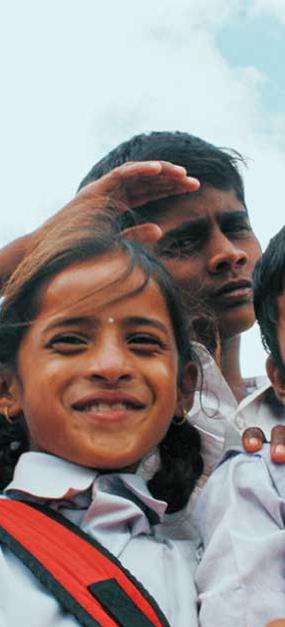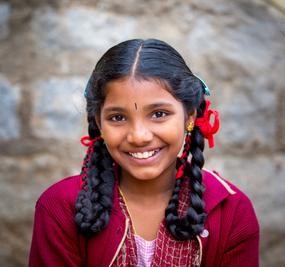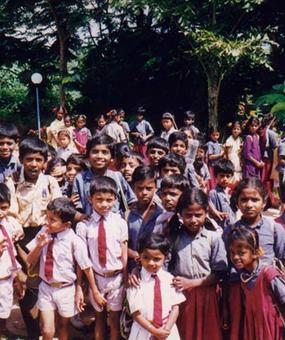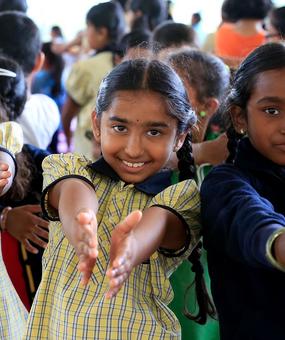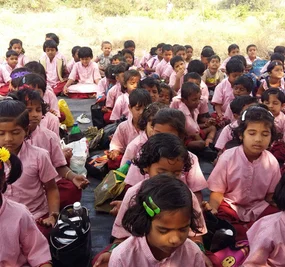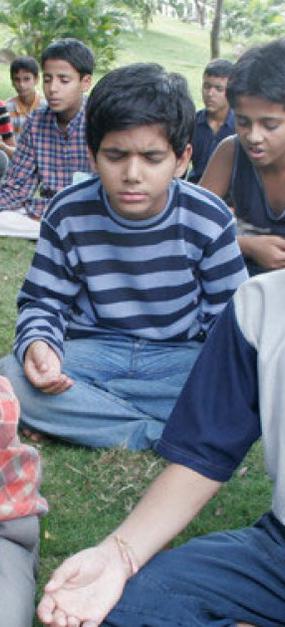

Free Schools: Spreading education to India’s remotest corners
Providing free holistic education to disadvantaged children in remote tribal areas, villages, towns, and cities.

Strategy
- Educating parents and elders
- Training teachers
- Formal teaching with skills training

Impact
1,00,000+ children are being educated in 1,356 free schools across India.

Gender ratio
The gender ratio in our schools is significantly higher than the national average.
Overview
Our vision is to provide value-based holistic education in a stress-free environment to children from vulnerable communities in India. Over the last three decades, The Art of Living has successfully executed educational projects that integrate values into the education system and provide livelihood options and a safe future for children. The Art of Living currently operates 1,356 free schools catering to almost 1,00,000+ children across 22 states in India. Our education initiatives include:
- Free schools which run in rural areas, urban slums, and remote tribal regions which have no access to road and electricity
- School adoption program where we assist government schools with infrastructure and manpower
- Mentoring programs for students vulnerable to crime and addictions in slums in urban cities.
During the course of building and running free schools, The Art of Living teams have encountered and addressed innumerable challenges. We have learned that teaching our children is perhaps the easiest process in the entire cycle. Changing the mind-set of the surrounding community and helping them to see the value of education, however, poses significant challenges, and this has been the unique value that the Art of Living has brought into the space of value-based education.
Free Education
Gift a Future
The school’s (free school in Bengaluru) faculty is really good. My village people are so proud of me that they are now willing to listen (and send their children to…

Priyanka N
First driver of Bengaluru’s metroline, ex-student of The Art of Living free school
If I had stayed back in Meghalaya I would have been married at a young age. Here I got an education and now I feel that I can achieve something…

Ridalin Lyngdoh
ex-student of The Art of Living free school, Bengaluru
I am a mason. I can’t pay the fees for my daughter’s school. Sri Sri Gnan Mandir helped me to give free and value-based education to my child. Due to…

Ajit Jadhav
Parent, Sri Sri Gnan Mandir Shignapur, Tal- Maan, Dist – Satara
Challenges
Almost 40% of the Indian population is under the age of 18. In April 2010, India joined the league of 135 countries that has made education a fundamental right of every child. Implementing the Right to Education and providing education to nearly 500 million people in India is a daunting task. The Art of Living shares this challenge with the government and other agencies in bringing education to the most deserving children and youth in the country. It is estimated that though nearly 96% of children start primary education in India, 72% finish class V, 57% finish class VIII and barely 37% end up finishing class X.
Some of our challenges include:
- Parents do not enrol their children in school due to a variety of socioeconomic issues.
- Children drop out after a period of attendance due to domestic pressures.
- Student performance decreases with time as they encounter personal, social, and economic problems
- Teachers may quit for better opportunities
We have found innovative solutions to overcome these challenges. Our risk mitigation strategy involves taking a holistic approach that involves not only the children, but their parents, the community, and the teachers.
≈ 66%
* Education rate in 2016
under-educated in India
People with less than 5 years of schooling
≤ 37%
of those who start primary education
finish class X
India has a high school drop-out rate
Education is civilization’s greatest leveler. It has the power to empower the weakest of the weak, bring peace to the world, and alleviate poverty. It is often seen as the only lit path in the pursuit of happiness.
Gurudev Sri Sri Ravi Shankar
Strategy
We have a well-defined strategy for our education projects that has been developed and refined with time. This strategy is built on three pillars:
Engaging with the community: The Art of Living proactively reaches out to community influencers to ensure that the children stay in school. We educate their parents and other family members about the importance of education even before the children are taught. School teachers are chosen from the community itself and are trained appropriately to ensure that the bond with the community is strong. This results in a low dropout rate.
Providing free education: The majority of the students at our schools are first-generation learners who come from backgrounds of extreme poverty. The Art of Living provides free and value-based education to children from vulnerable sections while addressing the social, economic, and cultural barriers that keep children away from school.
Value-based education: The Art of Living schools nurture a child holistically. A major focus of our education strategy is to combine formal education with life skills that include building the child’s confidence, leadership, and interpersonal skills and developing spiritual tools through meditation techniques and a foundation of human values. As a result, family values are strengthened, and progressive attitudes diminish social and cultural barriers.

Engaging with the community
Choosing and training teachers from the community

Providing free education
Most of the children are first generation learners

Value-based approach
Developing confidence, leadership, interpersonal skills and spiritual tools
Free Education for first generation learners
Impact
As the result of our sustained efforts in this sector, The Art of Living today operates 1,356 free schools catering to almost 1,00,000+ children in tribal regions, rural areas, and urban slums across 22 states in India. Highlights of our schools include:
- Most of the children are first generation learners.
- Many of our schools are located in areas without government-run schools.
- Students are given clothes, shoes, books, writing materials, bus service, and daily mid-day meals.
- We teach yoga, meditation, sports, and creative activities like dance, music, drawing, and painting to promote a healthy body and mind.
- Our schools have a gender ratio of 48 girls to 52 boys, which is higher than the national average.
- To date, we have trained about 2,000+ teachers.
1,00,000+
students
are being provided free education
1,356
free schools
operated across 22 states in India
2,000+
teachers
trained so far
48 : 52
girls to boys ratio
higher than the national average



